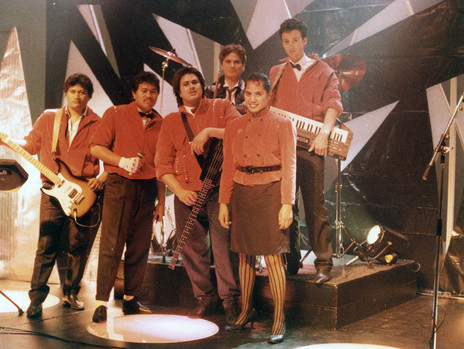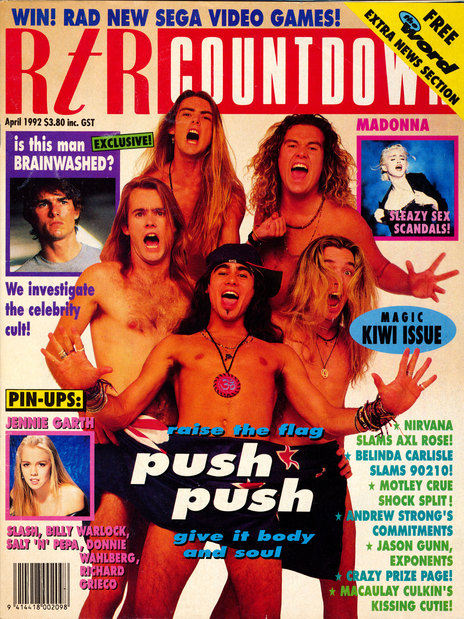TVNZ’s news hour at 6pm has always rated big, but from the late 1970s it had a rival. At its height, TV2 pop chart show Ready to Roll was reaching 1.2 million New Zealanders – at the time, a third of the population.
Ready to Roll had groovy opening titles, animated by Mike Peebles to the tune of The Commodores’ ‘Machine Gun’, and it counted down New Zealand’s Top 20 singles chart with a selection of overseas and local music video clips.
Ready to Roll opening theme: the original, using 'Machine Gun' by The Commodores.
“For a lot of Kiwis it was where they got their pop fix, their primer for going out on the town that Saturday night, and it influenced their record purchases the following week,” says Peter Blake, who joined the show when it began in 1975 as a talent co-ordinator and became producer in 1981.
Blake, a musician, had been working on Grunt Machine, but as post-hippie rock gave way to 1970s pop, TVNZ decided it wanted something with more mass appeal – and it had the first national sales chart, launched in May 1975, to draw on.
Blake remembers the team searching for a title for the show and that Ready to Roll was “chosen from a short-list of ideas. It was derived from the then-video machine record term ‘ready to roll’ and I guess, it also meant ‘ready to rock’n’roll’.”
The one thing that everyone remembers is the opening music, even if they didn’t know it was The Commodores. Blake recalls the team hunting for theme tracks and that the show’s first producer, Brian Lennane, made the final decision because “The Commodores vibe was hot at the time and their funky clavinet instrumental ‘Machine Gun’ gave punch and cutting potential for programme title animation”.
At its outset in 1975, Ready to Roll was bridging the gap between our variety-show past and music-video future. It was presented by Roger Gascoigne and featured comedy interstitials courtesy of Stu Dennison in his “Nice One, Stu!” persona. As with its predecessors C’mon! (1967-69) and Happen Inn (1970-73), local artists were filmed in the studio covering the hits of the day. You might see Sharon O’Neill singing Linda Ronstadt’s ‘Blue Bayou’; Annie Whittle belting out ‘Love Hurts’; Barry Saunders covering Eric Clapton’s ‘Wonderful Tonight’; or, incredibly, The Scavengers knocking out ‘Pretty Vacant’.
Blake also recalls Mi-Sex doing Elvis Costello & the Attractions’ ‘(I Don’t Want to Go to) Chelsea’; Rob Winch covering ‘Baker Street’; and Wellington band Redeye rocking out to ‘Cocaine’.

The Scavengers perform on Ready To Roll, September 1977. - Jeremy Templer
The real story, however, was the growing influence of the show on record sales. In the absence of a video clip for the first big hit from Grease, Blake put Tina Cross and Graham Chapman of Salty Dogg together for ‘You’re the One That I Want’, propelling the song to No.1 for four weeks in 1978.
“Which meant it repeated every week while it remained at the top of the charts,” says Blake. “The record company was ecstatic, selling many records of the original.”
There were also dance interpretations, à la Top of the Pops’ Pan’s People in the UK. Ngā Taonga Sound & Vision lists many undigitised Ready to Roll clips in its catalogue, including “TV ONE dancers perform dance sequence in park to Tragedy” and “Dancers dance to Herb Alpert music Rise”.
Wellington choreographer Trish Hodgson, who had danced on Happen Inn, was given the task. After Blake selected a current pop track, she would choreograph, rehearse the dancers and a clip would be shot at Studio 8, Avalon.
The middle-of-the-road variety era was still in full swing on New Zealand telly in the mid-1970s, says Blake, although the dancers were discontinued in 1977.
Ready to Roll NZ Record Awards Special, 16 September 1978, filmed at Avalon, with performances from John Rowles, Sharon O’Neill, the Rodger Fox Big Band, Hello Sailor, Toni Williams and Golden Harvest. Hosted by Stu Dennison, just two awards are covered: single and album of the year. President of RIANZ Tim Murdoch says a few words.
New Zealand artists did get a look-in, even though the charts at the time are largely full of international artists. Well before NZ On Air began its music-video funding scheme, New Zealanders who made it into the charts were flown to Wellington to perform in the studio.
There’s ‘I Need Your Love’ from Golden Harvest, in which the glare of the studio lights off lead singer Karl Gordon’s shiny pants is fair blinding.
Jon Stevens’ ‘Montego Bay’ was a hit in 1980 and he remains the only local artist to knock himself out of the No.1 spot, when ‘Montego Bay’ replaced ‘Jezebel’.
In 1975, Mark Williams was the first local act to go to No.1 (with ‘Yesterday Was Just the Beginning of My Life’) and he was No.1 again two years later with ‘It Doesn’t Matter Anymore’.
Gascoigne recalled to NZ On Screen, “We churned out covers of overseas hits by the dozen until the arrival of: the music video. I got to introduce Queen’s ‘Bohemian Rhapsody’ one evening ... and the world changed forever.”
As the 1970s came to a close, pop music was changing. MTV launched in 1981 in the US and the era of the music video began. In his new role as producer of Ready to Roll and Radio with Pictures, Blake was determined to get rid of the cover versions and start fostering local music.
The hope was that local record companies would be part of this revolution, but there was a reluctance to back local artists from both the record companies and radio.
“Unfortunately few local artist clips were produced by their respective New Zealand record companies, which is why we got involved,” says Blake. Clips made by the rock unit occasionally fitted both programmes, RTR and RWP. “Those in this category were generally played on cutting edge RWP first as it was felt that inclusion on RTR might pigeonhole them in the pop category.”
Bands were filmed in the studio, or Blake would commission videos. Simon Morris, who was working for RWP, directed classics such as Sharon O’Neill’s ‘Maxine’, the Dance Exponents’ ‘Victoria’ and The Screaming Meemees’ ‘See Me Go’, the first local single to enter the charts at No.1. In Dunedin, cinematographer Peter Janes worked with many of the emerging Flying Nun bands.
Other local clips on RTR that are (now) classics include Th’ Dudes’ ‘Be Mine Tonight’; Hello Sailor’s ‘Blue Lady’; Deane Waretini’s ‘The Bridge’; Netherworld Dancing Toys’ ‘For Today’; The Chills’ ‘Pink Frost’; and the Pātea Māori Club’s mega-hit ‘Poi E’, which spent a month at No.1 in 1984.
Although Blake and his team were “left to it” by the network, it was tough competing against the slick international clips: in 1985, The Chills and Netherworld Dancing Toys were in the charts up against ‘Flashdance’ and Madonna’s ‘Into the Groove’.
Radio never really came to the party, either. Local songs and other alternative tracks went into the charts despite never being played on radio: both ‘Love Will Tear Us Apart’ and ‘Atmosphere’ by Joy Division went to No.1 in 1981 and it was the video clip of ‘Poi E’ (first broadcast on Te Karere) that helped propel it to the top, not radio play. There was even a rumour that the sales of ‘Love Will Tear Us Apart’ were fabricated “by the record company buying countless singles or even hipster record shop employees filing false sales returns,” says Blake. “No proof ever materialised.”

Ardijah filming for Ready To Roll at Avalon studios, Lower Hutt, 1985. From left: Teina Benioni, Tony Nogotautama, Ryan Monga, Richie Campbell, Betty-Anne Monga, Simon Lynch. - Simon Lynch collection
The late 80s and early 90s became a boom time for music television. There were so many videos coming in, offshoot RTR shows were created to accommodate the volume and appease the record companies. RTR Video Releases led the spinoffs in 1982 (for songs “bubbling under the Top 20”; later re-named RTR New Releases), followed by RTR Mega-mix in 1988, and RTR Sounz in 1989.
Blake wrote a new theme tune in the early 80s, a bouncy number that sprang from his experiments with the new technology of synthesizers and drum machines, “which were also influencing pop music arrangements at the time”. In 1987, the original show was rebranded as RTR Countdown, and there was another titles update in the late 80s featuring a dancing figure called Start, created by visual effects whiz John Sheils.
Despite all the offshoot shows, the RTR brand was losing its gloss. Competition arrived from new channel TV3, which launched Shakedown in 1989 and TVFM in 1991, the same year that RTR was cancelled. It had set the scene, however, for the slew of music shows that would follow in the 90s, including Frenzy, Music Nation and Squeeze. Max TV began in 1993 and Juice TV in 1994. TVNZ also experimented with MTV.
There was a dilution, says Irene Gardiner, who worked in the TVNZ music unit at Avalon as a trainee director in the late 80s. RTR Countdown left prime-time “because the music video thing just wasn’t so new and special any more” and those massive ratings disappeared. In 1986, a dispute between the record companies and TVNZ about payment for music videos also didn’t help, as TVNZ took all its music shows off air.
Mandy Toogood, who worked on the show between 1984 and 1989 and became producer after Peter Blake, remembers a slow decline in viewership as more options became available. In its heyday, Ready to Roll was, in the pop genre, “the only way you could see what was happening, especially with international music”. The charts were also important as, “back then, you could only buy the CD or the record,” says Toogood, “but now, there’s so many different ways of getting music, it’s not quite the same.
“Nobody would watch a music show now.”
Ready to Roll’s name change to RTR Countdown came in 1987, when the magazine, edited by Gary Steel, was launched. The show, along with all of TVNZ’s music output, was moved to Auckland’s “rock unit” and Robert Rakete shepherded RTR through its final years in the early 90s. Then there was a surprising revival in 2000, which was hosted by Erika Takacs and lasted four years.

Push Push on the cover of RTR Countdown, April 1992
But the seismic changes wrought by the internet and music- and video-sharing websites mean that we no longer need a TV show to tell us what is hot or not – we can curate our own charts, especially since the arrival of the first iPod in 2001 and YouTube in 2005. As charts lost their meaning, TV music shows took a hit. In the UK, Top of the Pops, which began in 1964, threw in the towel in 2006.
Sales charts are still a thing: the Billboard 100 is a big deal in the US, but the music industry has had to pivot to a new world in which kids are making and uploading their own music and where an artist on TikTok can have a hit that goes to No.1 every time it is remixed.
Even music video clips aren’t what they were, but looking back on an era when local music struggled for recognition, as a cultural force, RTR played its part.
--